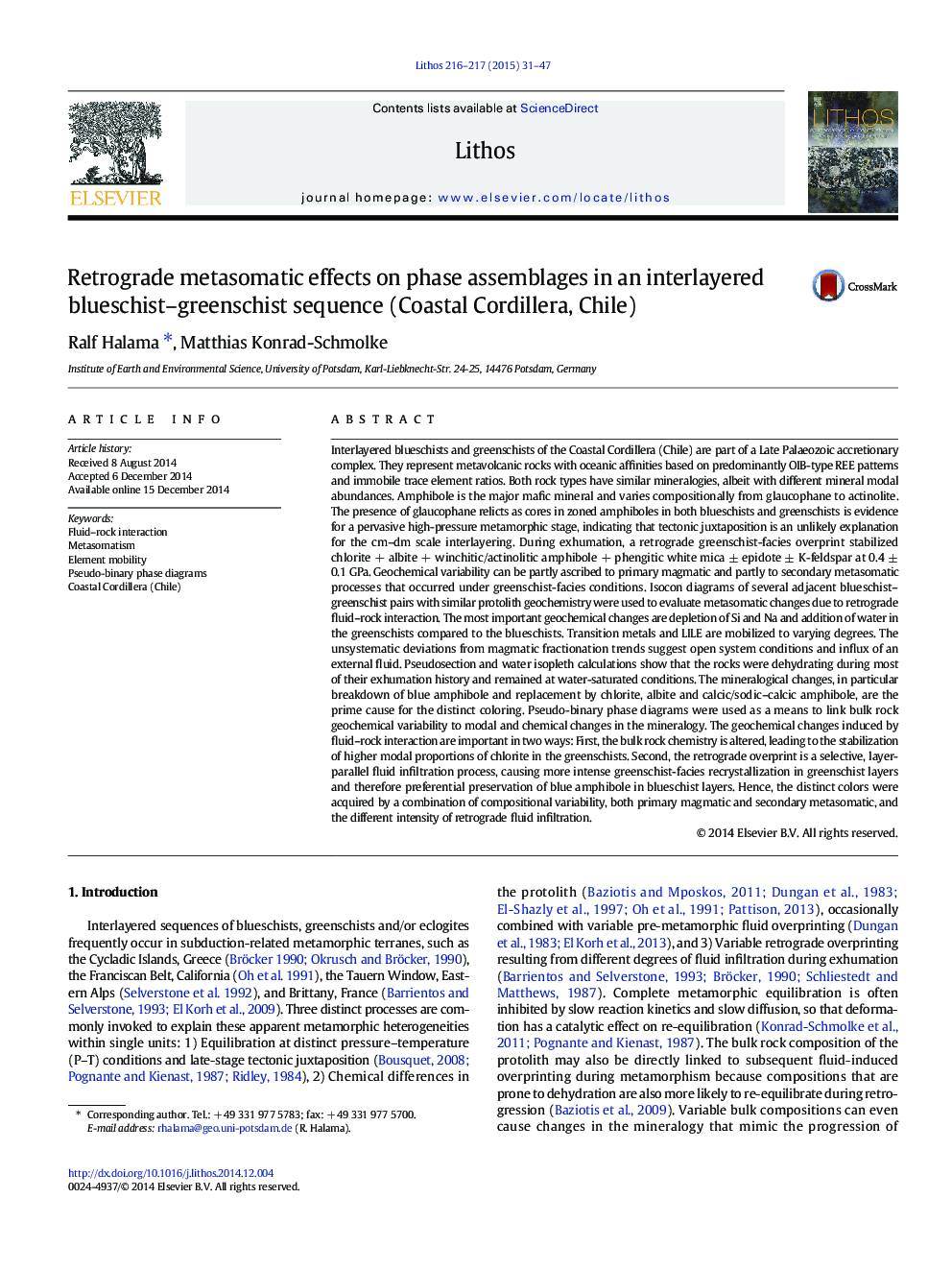| کد مقاله | کد نشریه | سال انتشار | مقاله انگلیسی | نسخه تمام متن |
|---|---|---|---|---|
| 6440760 | 1638668 | 2015 | 17 صفحه PDF | دانلود رایگان |
عنوان انگلیسی مقاله ISI
Retrograde metasomatic effects on phase assemblages in an interlayered blueschist-greenschist sequence (Coastal Cordillera, Chile)
دانلود مقاله + سفارش ترجمه
دانلود مقاله ISI انگلیسی
رایگان برای ایرانیان
کلمات کلیدی
موضوعات مرتبط
مهندسی و علوم پایه
علوم زمین و سیارات
ژئوشیمی و پترولوژی
پیش نمایش صفحه اول مقاله

چکیده انگلیسی
Interlayered blueschists and greenschists of the Coastal Cordillera (Chile) are part of a Late Palaeozoic accretionary complex. They represent metavolcanic rocks with oceanic affinities based on predominantly OIB-type REE patterns and immobile trace element ratios. Both rock types have similar mineralogies, albeit with different mineral modal abundances. Amphibole is the major mafic mineral and varies compositionally from glaucophane to actinolite. The presence of glaucophane relicts as cores in zoned amphiboles in both blueschists and greenschists is evidence for a pervasive high-pressure metamorphic stage, indicating that tectonic juxtaposition is an unlikely explanation for the cm-dm scale interlayering. During exhumation, a retrograde greenschist-facies overprint stabilized chlorite + albite + winchitic/actinolitic amphibole + phengitic white mica ± epidote ± K-feldspar at 0.4 ± 0.1 GPa. Geochemical variability can be partly ascribed to primary magmatic and partly to secondary metasomatic processes that occurred under greenschist-facies conditions. Isocon diagrams of several adjacent blueschist-greenschist pairs with similar protolith geochemistry were used to evaluate metasomatic changes due to retrograde fluid-rock interaction. The most important geochemical changes are depletion of Si and Na and addition of water in the greenschists compared to the blueschists. Transition metals and LILE are mobilized to varying degrees. The unsystematic deviations from magmatic fractionation trends suggest open system conditions and influx of an external fluid. Pseudosection and water isopleth calculations show that the rocks were dehydrating during most of their exhumation history and remained at water-saturated conditions. The mineralogical changes, in particular breakdown of blue amphibole and replacement by chlorite, albite and calcic/sodic-calcic amphibole, are the prime cause for the distinct coloring. Pseudo-binary phase diagrams were used as a means to link bulk rock geochemical variability to modal and chemical changes in the mineralogy. The geochemical changes induced by fluid-rock interaction are important in two ways: First, the bulk rock chemistry is altered, leading to the stabilization of higher modal proportions of chlorite in the greenschists. Second, the retrograde overprint is a selective, layer-parallel fluid infiltration process, causing more intense greenschist-facies recrystallization in greenschist layers and therefore preferential preservation of blue amphibole in blueschist layers. Hence, the distinct colors were acquired by a combination of compositional variability, both primary magmatic and secondary metasomatic, and the different intensity of retrograde fluid infiltration.
ناشر
Database: Elsevier - ScienceDirect (ساینس دایرکت)
Journal: Lithos - Volumes 216â217, February 2015, Pages 31-47
Journal: Lithos - Volumes 216â217, February 2015, Pages 31-47
نویسندگان
Ralf Halama, Matthias Konrad-Schmolke,